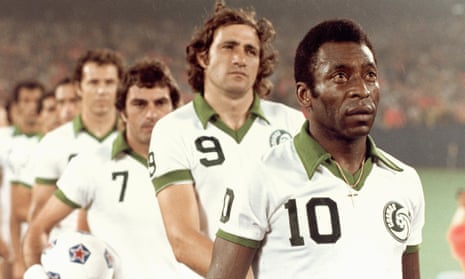In the 1970s, the New York Cosmos made soccer briefly fashionable in the United States, with global superstars Pelé, Franz Beckenbauer and Carlos Alberto leading a glittering team through a league that defied every convention of the international game.
How much would it cost to assemble an equivalent team today?
About $175m.
That’s the bottom line of a rough estimate taking the roster of the 1977 Cosmos, which included Pelé for the last time and won the first of the team’s four NASL championships in six years, and converting the players to modern equivalents.
Big European clubs have built up to that level over generations. The Cosmos did it in a three-year spree that isn’t likely to be duplicated in an era of astronomical transfer fees and club executives trying to avoid seeing the bubble burst – as it did for the Cosmos and the NASL itself in the mid-80s.
The Cosmos weren’t building completely from scratch. The team first competed in 1971 and won a league title in 1972. But they were not good, even by the lowly standards of 1974 – had the NASL used a traditional points system and a promotion/relegation system, New York may have enjoyed second-division soccer in 1975.
Instead, the Cosmos signed Pele. They added a few more moderately expensive players in 1975 and 1976, then broke the bank again to sign the captains of the last two World Cup champions – Carlos Alberto and Franz Beckenbauer.
Here’s how the analysis worked: for each player on the team’s 1977 roster, we came up with a modern analogue. For example: for Carlos Alberto, the defensive star of the 1970 World Cup champions, substitute Spanish defender Sergio Ramos. Then we checked the modern-day player’s estimated value at transfermarkt.com.
Two players weren’t easy to classify. The obvious analogue for Pele, a global megastar and one of the best players of all time, is Lionel Messi. But Messi is 29 today. Pele signed with the Cosmos at age 34. He was no longer in his prime, but the Cosmos certainly had to spend a lot to get him in 1975, and there’s no doubt a team would have to spend a lot to land Messi in five years. David Beckham, the biggest celebrity to play in the USA in the Major League Soccer era, was just past his playing peak and still required a complex deal that included an option for club ownership after he retired. Still, cutting Messi’s current estimated value of €120m in half, at €60m or $64.2m, seems fair.
Beckenbauer was the captain and defensive leader of the reigning World Cup champions. Coincidentally, Germany are the reigning World Cup champions today, and captain Philipp Lahm is a defensive player in his early 30s, like Beckenbauer when he joined the Cosmos. But Lahm’s listed value of €13m isn’t enough for a revolutionary player like Beckenbauer. Double that to €26m ($27.82m).
For the rest of the Cosmos roster, we looked for modern-day players of roughly the same age and experience, preferably the same nationality. Giorgio Chinaglia was a prolific but erratic Italian forward – maybe like Mario Balotelli? Bobby Smith was a US national team defender and solid US league player, like Matt Besler. Tony Field wasn’t a star in England but shone in the USA, like New York Red Bulls scoring machine Bradley Wright-Phillips.
Then we did two separate calculations.
First, add up the estimated value of the players who joined the Cosmos in 1975-1977 and stayed until 1977. That eliminates US goalkeeper Bob Rigby (1976 only), aging Uruguayan defender Omar Caetano (1975 only) and a few others. Assume that, in this hypothetical market, the Cosmos managed to sell these players and get back most of their money. Or maybe they just wrote it off somewhere deep in the books of Warner Communications, the team’s corporate backers.
So the players counted from 1975’s signings are Pele, young English defender Mike Dillon, Peruvian World Cup veteran Ramon Mifflin and Nelsi Morais, a Brazilian favored by Pele. Total value: $71,315,500.
The 1976 players: Chinaglia, Field, Smith, Aston Villa appearance record-holder Charlie Aitken, English yo-yo club journeymen Terry Garbett and Keith Eddy, and prodigal goalkeeper Shep Messing. Total value: $15,247,500.
The 1977 crew was expensive: Carlos Alberto, Beckenbauer, Turkish goalkeeper Erol Yasin, little-known but productive Yugoslavian attacker Vito Dimitrijevic, English scoring prospect Steve Hunt, South African great Jomo Sono, longtime Santos defender Rildo, mid-career Yugoslavian forward Jadranko Topic and a quartet of North American prospects: Bob Iarusci, Gary Etherington, Bruce Twamley and Paul Hunter. Total value: $91,485,000.
Grand total: $178,048,000.
That’s the first measure. The second simply takes the value of the Cosmos’ top 18 players from 1977, which gives us a baseline of comparison to TransferMarkt’s most valuable clubs of today. So we’ll subtract the less valuable players but add the one significant holdover from the old Cosmos days – US defender Werner Roth, a latter-day Geoff Cameron.
Total value of the top 18: €166,450,000 or $178,101,500.
That’s still nowhere near the top-18 values of Real Madrid (€739m), Barcelona (€734m), the two Manchester clubs (€487m each) or other clubs in the top 10. But it’s more than ambitious European clubs like Porto, Lyon, Monaco, Villarreal, Fenerbahce and Ajax.
And it’s surely more than any club outside the global top 10 will be able to spend in one massive spree any time soon.
This article includes content provided by Google. We ask for your permission before anything is loaded, as they may be using cookies and other technologies. To view this content, click 'Allow and continue'.

Comments (…)
Sign in or create your Guardian account to join the discussion